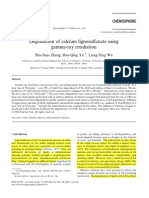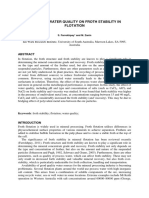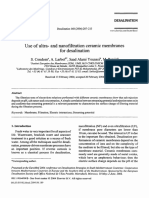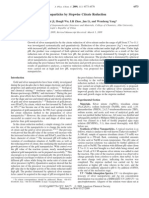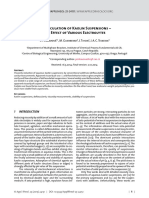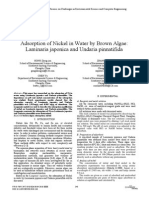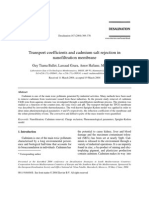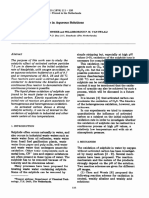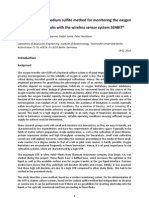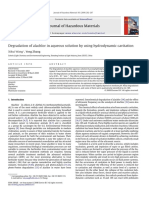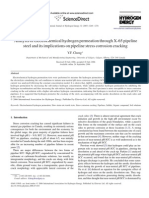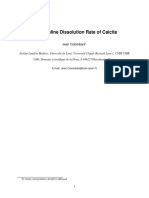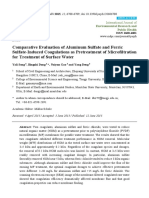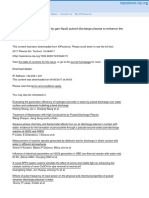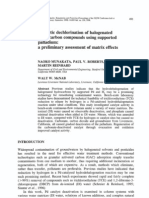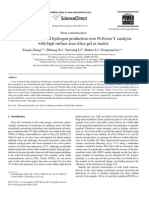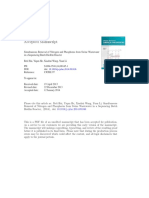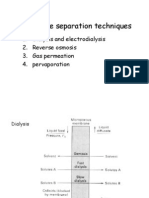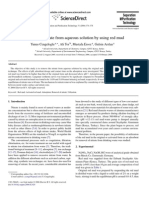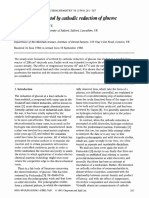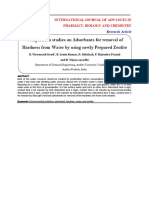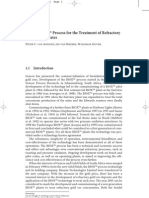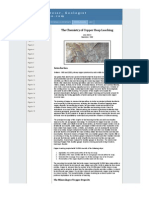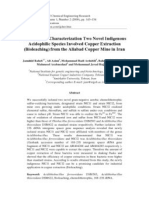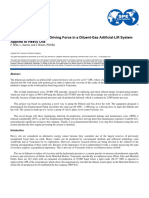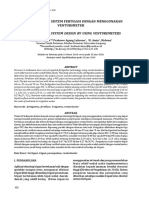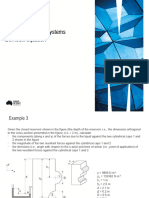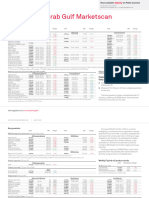Of Cac03: Inhibition Scaling in Reverse Osmosis System by Zinc Ion
Of Cac03: Inhibition Scaling in Reverse Osmosis System by Zinc Ion
Uploaded by
donsombreroCopyright:
Available Formats
Of Cac03: Inhibition Scaling in Reverse Osmosis System by Zinc Ion
Of Cac03: Inhibition Scaling in Reverse Osmosis System by Zinc Ion
Uploaded by
donsombreroOriginal Title
Copyright
Available Formats
Share this document
Did you find this document useful?
Is this content inappropriate?
Copyright:
Available Formats
Of Cac03: Inhibition Scaling in Reverse Osmosis System by Zinc Ion
Of Cac03: Inhibition Scaling in Reverse Osmosis System by Zinc Ion
Uploaded by
donsombreroCopyright:
Available Formats
Chinese J. Chem Eng.
, 14(2) 178-183
(2006)
Inhibition of CaC03Scaling in Reverse Osmosis System by Zinc Ion*
YANG Qingfeng(& ah$)**
School of Environmental Science and Engineering, Shanghai Jiao Tong University, Shanghai 200240, China
Abstract Scaling of reverse osmosis (RO) membrane surface is one of the main problems in desalination processes. To mitigate scales, organic anti-scalants are often used. If the dosages of anti-scalants are reduced, by using other much cheaper scale inhibitors, RO running cost will decrease greatly. The present paper investigated the inhibition of CaC03 precipitation by zinc ions in RO system. The results show that the zinc ion concentration of 2mgL-' was able to exert a marked suppression effect on both bulk precipitation of CaC03 and on membrane scaling on waters of moderate hardness. Keywords reverse osmosis, desalination, scaling inhibition, metal impurities
1 INTRODUCTION Scaling on heat transfer surface['41 and reverse ~'~~ osmosis (RO) membrane s u r f a ~ e [is one of the main problems in desalination processes. To mitigate scales, anti-scalants are often used. However, anti-scalants are expensive and sometimes will result in environmental problems. There is ample evidence in the literature that small amounts of metal ion impurities, such as Fe, Mg, Cu and Zn, which are commonly encountered in water, can affect the nucleation and crystallization rates of precipitating CaC03 and induce morphological changes of the crystal habit. The literature cites Zn2+ ions are being particularly effective in suppressing CaCO3 scale depositi~n'~-~I. Abouali et u Z . ' ~ ] showed that scale precipitation was completely prevented during the experimental observation time by dosage of 600p.g-L-' Cu2+ or 50pg.L-' Zn2+. Coetzee et al.[*] reported that Cu2+was found to be only half as effective as Zn2+while Mg2+required concentration levels loo0 times larger to produce comparable effects. Per~] not et ~ l . ' indicated that OSmg-L-' of Zn2+has the same inhibition effect as 2mg.L-' Fez+ for CaC03 scale. But the full potential of Zn2+for scale suppression has been very scantily explored so far. Furthermore, there are no studies in literature on the scale inhibition by zinc in RO system. Unlike other scale formation cases, the RO system has a great concentration effect for the solution.
This paper presents an investigation of zinc to prevent CaC03 scale precipitation on RO membranes. Both full recycle and partial recycle operation modes are adopted for the performed experiments.
2 EXPERIMENTAL 2.1 Experimental system Experiments were conducted in a continuous flow tubular RO system (Fig.1). The RO tubular element (diameter 14.5mm, length lm) consisted of a high rejection polyamide/polysulfone composite RO membrane. Operating pressures were in the range of 3.5-4.5MPa, providing initial permeate fluxes in the range of 20-50L.h-'.m-2. Feed velocity in the various runs was in the range of 0.25-0.47m.s-'. The recycling solution was held at a constant temperature of 30C by a thermostatic controlled heating element and a water cooled heat exchanger. Solution pH was held constant at a desired level by a pH controller which either actuated a NaOH dosing pump or opened a C02 solenoid valve. The experimental system enabled two modes of operation. In the f l recycle (FR) mode, both permeate ul ak and concentrate streams were returned to the feed t n , thus maintaining a constant composition of the solution flowing through the membrane, till the eventual onset of bulk precipitation. In the permeate withdrawal (PW) mode, permeate was withdrawn from the system, leading to continuous concentration of the recycling solution which eventually led to bulk precipitation.
Received 2005-04-29, accepted 2005-12-19.
* Supported by the National Natural Science Foundation of China (No.20306015) and the Scientific Research Foundation of the
State Education Ministry for Returned Overseas Chinese Scholars (No.[2003]406).
** To whom correspondence should be addressed. E-mail: yangqf@sjtu.du.cn
Inhibition of CaCOJScaling in Reverse Osmosis System by Zinc Ion
179
Flow meter
W c
I
--LFeed vessel Filter
L '
Heat exchanger
2 . g e
$3
*
Flow I meter I
U'
Figure 1 RO experimental system
2.2 Feed solution
Solutions having a propensity for CaC03 precipitation were prepared in a 30-L feed tank with distilled water by dissolving 610mg.L- of CaC12, 5llmg.L-' of NaHC03 and 49mg.L-' of MgS04. A desired supersaturation potential of CaCO3 was adjusted by careful addition of NaOH solution to the pH level providing the desired LSI level. The FR experiments were carried out at initial pH values in the range of 7.6-8.2, providing initial LSI values in the range of 1.0-1.6. The PW experiments were carried out at an initial LSI value of 1.2 and an initial pH level of 7.7.
2.4 Method of analysis
'
Since scale deposition induces a continuous decline in permeate flow rate, the inhibition effectiveness of Zn2+ ions was assessed by comparing membrane permeability decline with time in the presence and in the absence of Zn2+ions. Membrane permeability Lp is given by:
Lp =-
JV
(1)
P-nm where Jv is the permeate flux, p is the operating pressure and ~r,the osmotic pressure prevailing on the is membrane wall. The magnitude of rm is affected by the concentration polarization phenomenon. However, since in the present work osmotic pressure was significantly lower than the operating pressure, little error was introduced by approximating wall osmotic pressure iq,, with bulk osmotic pressure 7tb. The fundamental parameter dictating the scaling potential is the supersaturation level prevailing on the membrane surface. The value of the concentration polarization (CP) modulus, which is required for evaluating membrane wall conditions, was roughly calculated by assuming that diffusivity coefficients of all ions except H+ were equal and that H+ diffusivity was an order of magnitude higher"0-'21.
2.3 Experimental procedure
Characterization of the inhibition effectiveness of Zn2+ions in full recycle experiments was carried out by measuring permeate flow rate, solution composition and solution turbidity versus time. In the permeate withdrawal experiments, water recovery fraction versus time was also measured. In FR runs, the LSI level was maintained constant throughout the experiment by pH control of the recycling solution. Calcium carbonate scaling on the membrane was indicated by permeate flux decline while bulk precipitation was detected by a sharp turbidity increase. At the end of the induction period, the onset of precipitation led to a sharp decrease of the LSI level as a result of the pH decrease accompanying CaC03 formation and of the depletion of the scaling species from the solution. In PW runs, the pH level was also maintained constant but the LSI level continuously increased as a result of the solution concentration effect. As before, both the LSI and the pH levels rapidly decreased after the onset of precipitation.
3 RESULTS AND DISCUSSION 3.1 Full recycle experiments
The inhibition effectiveness of Zn2+ can be roughly assessed by comparing the permeability ratio Lp / Lpo in the absence and in the presence of Zn2+ions, where Lp is the fouling membrane permeability and Lpo is the clean membrane permeability. Results of the experiments conducted at the LSI
Chinese J. Ch. E. 14(2) 178 (2006)
180
Chinese J. Ch. E. (Vol. 14, No.2)
levels of 1.1, 1.4 and 1.6 are shown in Fig.2. The solution pH values for the LSI levels of 1.1, 1.4 and 1.6 are 7.6, 8.0 and 8.2, respectively. At the lower LSI levels of 1.1 and 1.4, membrane permeability remained substantially constant in the presence of 2mg.L-' Zn2+ while a marked permeability decline process occurred in the absence of zinc. It may be noted that the marked permeability decline observed in Fig.2 at the relatively low LSI level of 1.1 in the solution was not accompanied by bulk precipitation throughout the 16 hours of the experiment. The dissolved Ca2' concentration remained constant and no solution turbidity was detected.
1.oo
0.95 0.90 0.85
s Y
4 -
time, h
Figure 2 Relative permeability versus time W LSI=1.1, balnk, 0 LSI=l.l,Zn=2mg.L-'; LSI=1.4, blank; LSI=1.4,Zn=2mg.L-'; 0 LSkl.6, balnk, 0 LSI=1.6, Zn=2mg.L-'
Figure 3 shows that at the LSI level of 1.4 bulk precipitation occurred in the Zn2+f e solution after a brief re induction period of lh. The presence of 2mgL-' Zn2+ was able to prevent bulk precipitation throughout an experiment conducted at the same LSI level of 1.4.
8888
Figures 2 and 3 also show that a 2mg.L-' dosage of ZnZ+ a solution having the higher LSI level of 1.6 in was not able to prevent the processes of permeability decline and of bulk precipitation. It may be therefore concluded that Zn dosage has a potential for inhibiting CaC03 scale deposition when the LSI level in the bulk of the solution is below 1.4. The precipitation tendency of Zn ions increases with the increase in the pH level. The LSI level in the various FR runs was fixed by adjusting the pH while maintaining the same solution composition. Thus the poor inhibitory performance of Zn at the LSI level of 1.6 was probably due not only to the increase in the CaCO3 precipitation potential but also to a decrease in Z solubility arising from the pH level of 8.2 (as n compared to the pH level of 7.6-8.0 prevailing in the runs at LSI of 1.1-1.4 which displayed amarked inhibition effect). The effect of Zn concentration on inhibition effectiveness was investigated, performed with dosages of 5 and lOmg.L-' Zn2+,respectively. The data obtained (Fig.4) clearly indicate that increase of the Zn2+ concentration beyond 2mg.L-' diminished the inhibition effectiveness. The permeability data show a progressive deterioration in membrane permeability with increase of the Zn level. In fact, the decrease in permeability with 10mg.L-' Zn2+is greater than that in the absence of Zn. Bulk precipitation, which was completely prevented by 2mg.L-' Zn2+ lasting 16h, occurred after 13.5h in the presence of 5mg.L-' Zn2+ and after 4h, in the presence of 1Omg-L-' Zn2+.
1.oo
..
0.95
88 8 B-
8888
250
B
0.90
- 200
5
4 -
0.85
0.75
- 50
0
o.80 0.70
i
I
'tt
L A
I
12
16
time, h
2
4 6
8
1 0 1 2 1 4
time, h
Figure 3 Ca& and turbidity versus time 0 LSI=1.4, blank, Ca"; W LSI=1.4, Zn=2mgL1,Ca"; LSI=ld, Zn=2mg-L-', Ca"; 0 LSI=1.4, balnk, turbidity; LSI=1.4,Zn=2mg.L-', turbidity; LSI=1.6,Zn=2mg.L-', turbidity
Figure 4 Relative permeability versus time LSI=1.4,Zn=SmgL-';A LSI=1.4,Zn=lOmg.L-'; 0 LSI=lA, blank; LSI=1.4,Zn=2mg.L-'
Solubility data indicate that the experimental solutions were supersaturated not only with respect to CaCO3 but also with respect to some Zn salts, notably Smithso-
April, 2006
Inhibition of CaC03Scaling in Reverse Osmosis System by Zinc Ion
nite [ZnCO3] and Hydrozincite [Z~~(CO~)Z(OH)~]. The
181
least soluble Zn salt is Hydrozincite which has a very low solubility, given by log(IAP)=-77.6 at room temperature. The solubility of Hydrozincite depends on the hydroxyl activity raised to the 6th power. Thus when augmenting the LSI level by increasing the pH of the solution, the precipitation tendencies of both CaCO3 and Hydrozincite are enhanced. Figure 5 shows the depletion of Zn2+from solutions. For the runs of different initial zinc concentrations but with the same initial LSI level of 1.4 and the same initial pH value of 8.0, the Zn depletion rate is more rapid the higher the initial Zn concentration. For the runs having the same initial Zn2+concentration of 2mg.L-' but different pH levels, it is seen that in run conducted at LSI=1.4 and pH=8.0 in which no bulk precipitation occurred, the Zn level remained substantially constant. On the other hand, in run conducted at LSI=1.6 and pH=8.2 in which bulk precipitation occurred, Zn depletion was rapid. It seems that the poor inhibitory effect of Zn at the high LSI value stems from the combined effect of co-precipitation and reduced Zn solubility.
Bl\
4-
12 16 time, h
20
24
experimental Ca2+ concentration coincided with the theoretical value calculated from the concentration effect due to permeate withdrawal, assuming no precipitation. Since the supersaturation level increases with the volume of permeating filtrate, a threshold LSI level, defined as LSII, is reached at which CaCO3 begins to precipitate on the membrane surface. The precipitation process is initiated on the membrane surface since it is exposed to a higher supersaturation level, due to the CP effect. At this stage there is no increase in solution turbidity but a decline in membrane permeability is observed. The depletion in dissolved Ca" concentration accompanying membrane scaling results in a deviation between measured and theoretically calculated calcium values. The continuous increase in solution supersaturation generated by permeate withdrawal ultimately leads to a threshold LSI limit, denoted as LSI;?, at which bulk precipitation is initiated. Bulk precipitation induces a rapid drop in the dissolved Ca2+concentration and a sharp increase in solution turbidity, with a concomitant drastic decrease in the solution supersaturation level. Consequently, the process of membrane permeability decline is virtually arrested. Figure 6 showing the changes in calcium concentration and turbidity level with the water recovery level highlights the three stages observed in the course of permeate withdrawal. The initial Ca2+concentration is seen to follow the theoretical concentration curve up to a certain recovery level corresponding to LSIl after which membrane scaling causes an increasing deviation between measured and theoretically calculated Ca2+values. The threshold LSIl level of 1.39 in the absence of Zn increases to 1.52 in the presence of zinc
600
Figure 5 Zn&declinewith various initial Zn concentrations W LSI=l.4,Zn=2mg.L-'; 0 LSI=1.4,Zn=Smg.L-'; A LSI=l.4,Zn=lOmg.L-'; LSI=1.6,Zn=2mgK1
500
1
I
3.2 Permeate withdrawal experiments The inhibitory effect of Zn in permeate withdrawal experiments was studied by performing a series of runs at initial Zn2+levels of 0 (blank), 2 and ~ m g . ~ -respectively. The initial solution LSI level in ', all experiments was 1.2 and all otsher experimental conditions were nominally identical. Membrane and solution performance in the PW experiments followed three stages. In .the initial stage, membrane permeability remained constant and the
10
20
30
40
50
60
recovery, %
Figure 6 Cab and turbidity with 2mgL-l Znk - ~ n = 2 m g ~ ' , no precipitation; Caz+ ~ n = 2 m g ~ ' , meas&, CaZ+ H Zn=2mg.L-', turbidity
C i e e J. Ch. E. 14(2) 178 (2006) hns
182
Chinese J. Ch. E. (Vol. 14, No.2)
with a corresponding increase of the water recovery level from 18% to 32%. At the critical supersaturation level LSI2, bulk precipitation is seen to cause a rapid increase in turbidity and a sharp decline in Ca" concentrations. The beneficial effect of Zn in moderating permeability decline during the membrane scaling phase is well reflected in the data of membrane permeability versus water recovery presented in Fig.7. It is seen that at a water recovery of 40%, a permeability decline of about 40% is observed in the absence of Zn. In the presence of 2mgL-' Zn,the permeability decline at a water recovery of 50% is about 10% and with 5mg.L-' Zn, the permeability decline is less than 5% at a water recovery of over 55%.
1.00,
of the theoretical curve assuming no precipitation with measured Zn values shows that part of the Zn was precipitating throughout experiment. However it is seen that the residual Zn concentrations in the solution prior to bulk CaCO3 precipitation were sufficiently high to provide a marked inhibitory effect. The higher dissolved Zn concentration in the PW experiments is most probably the reason why bulk precipitation was suppressed up to LSI2 levels in the range of 1.55 to 1.8, in contrast to the lower LSI limit found in the FR experiments. The higher Zn solubility in the PW experiments stems from the lower pH level of the solution-an initial pH of 7.7 as compared to the pH level of 8.2 maintained in the FR experiments carried out at LSI=l.6.
4 CONCLUSIONS
0.90
0.80
3
4 %
0.70 0.60
I I
t
I
10
20
30
40
50
recovery, % Figure 7 Relative permeability versus recovery b a l k , A Zn=2mg.L-'; 0 Zn=SmgL-'
Evidence linking high membrane permeabilities with the presence of Zn is given by the data of dissolved Zn concentration versus water recovery presented in Fig.8. Comparison of the Zn concentration
The results of this investigation indicate that dosage of trace amounts of Zn can induce a marked beneficial scale suppression effect within a certain range of water compositions. The results of the full recycle experiments suggest that a useful scale suppression effect might be exerted in treating concentrates at a membrane wall LSI level below about 2.0. Permeate withdrawal experiments extending over a period of 10h indicate the possibility of suppressing membrane permeability decline by 2 to 5mg.L-' Zn concentrations. The experiments indicate that several effects are involved in the Zn inhibition effect apart from the CaCO3 supersaturation level, notably Zn ion solubility in a solution of a given composition and Zn ion depletion by a pH related precipitation process.
NOMENCLATURE
r,
J"
P
r b
rl u
membrane permeability, ms-'.Pa-' permeate flux, m.s-' operating pressure, MPa bulk osmotic pressure, Pa osmotic pressure pvailing on the membrane wd,Pa
REFERENCES
1
10
20
30
40
50
60
recovery, %
Figure 8 Zn2' concentrationversus recovery ~ n = z r n g . ~ -measured zn2+; -~ n = 2 m g ~ ' , no ', Zn2+ precipitation; ~n=~mg.~-', measureti a2+; -.- z n = s m g ~ 'Zn2+ precipitation , no
April, 2@o6
Yang, Q.F., Ding, J., Shen, Z.Q., "Investigation on fouling behaviors of low-energy surface and fouling fractal characteristics", Chem Eng. Sci., 55(4), 797-805(2OOO). Yang, Q.F., Liu, Y.Q., Gu, A.Z., Ding, J., Shen, Z.Q., "Investigation of induction period and morphology of CaCO3 fouling on heated surface", Chem. Eng. Sci., 57(6 ,9213 1(2002). ) 'fet Yang, Q.F., Gu, A.Z., Ding, J., Shen, Z.Q., 'Efcs of
Inhibition of CaCOJScaling in Reverse Osmosis System by Zinc Ion
PAA and PBTCA on CaC03 scaling in pool boiling system, Chinese J. Chem. Eng., 10(2), 190-197(2002). Yang, Q.F., Gu, A.Z., Ding, J., Shen, Z.Q., Scaling and removal of calcium carbonate on electroless plating surface, Chinese J. Chem. Eng., 9(2), 150-155(2001). Yang, Q.F., Ma, Z.F., Yan, J.M., Investigation of CaC03 scaling and its inhibition in reverse osmosis desalting, Chem Ind. Eng. Pmgz, 22(supplement), 133-136(2003). Shih, W.Y., Rahardianto, A., Lee, R.W., Cohen, Y., Morphometric characterization of calcium sulfate dihydrate (gypsum) scale on reverse osmosis membranes, J. Membl: Sci., 252,253-263(2005). Abouali, E., Jean, 0.. Ledion, J., Influence of copper and zinc on the scaling properties of water, J. Eul: dHydl:, 27(2), 109-126(1996). Coetzee, P.P., Yacoby, M., Howell, S., Mubenga, S., Scale reduction and scale modification effects induced
183
10
ll
12
by Zn and other metal species in physical water treatment, Water SA, 24( l), 77-84( 1998). Pernot, B., Euvrard, M., Remy, F.,Simon, P., Influence of Zn(II) on the crystallization of calcium carbonate application to scaling mechanisms, J. Water Sew. Res. Tech. Aqua, 48(1), 16-23(1999). Hasson, D., Sherman, H., Biton, M., Prediction of calcium carbonate scaling rates, In: Proceedings of 6th International Symposium Fresh Water from the Sea, 2, 193-1 99( 1978). Hasson, D., Perl, I., Scale deposition in a laminar falling-film system, Desalination, 37,279-292( 198l). Chan, S.H., Ghassemi, K.F., Analytical modeling of calcium carbonate deposition for laminar falling films and turbulent flow in annuli: P r 1-formation and sinat gle-species model, J. Heat Transfer, 113(8), 735-740 (1991).
Chinese J. Cb. E 14(2) 178 (2006) .
You might also like
- Water Treatment Technologies for the Rem [Pages 177-182] [2025-01-28]No ratings yetWater Treatment Technologies for the Rem [Pages 177-182] [2025-01-28]7 pages
- Low-Pressure Reverse Osmosis As A Process For Treatment of Anionic Pollutants in Water EnvironmentNo ratings yetLow-Pressure Reverse Osmosis As A Process For Treatment of Anionic Pollutants in Water Environment5 pages
- Use of Ultra and Nanofiltration Ceramic Membranes For Desalination 2004 DesalinationNo ratings yetUse of Ultra and Nanofiltration Ceramic Membranes For Desalination 2004 Desalination7 pages
- The Specific Behaviour of NF Membranes in The Separation of High Ionic Strength Electrolyte SolutionsNo ratings yetThe Specific Behaviour of NF Membranes in The Separation of High Ionic Strength Electrolyte Solutions9 pages
- The Effect of Zeta Potential On The SedimentationNo ratings yetThe Effect of Zeta Potential On The Sedimentation14 pages
- Characterization of Acidity in ZSM-5 Zeolites: An X-Ray Photoelectron and I R Spectroscopy StudyNo ratings yetCharacterization of Acidity in ZSM-5 Zeolites: An X-Ray Photoelectron and I R Spectroscopy Study6 pages
- Separation and Puri Fication Technology: SciencedirectNo ratings yetSeparation and Puri Fication Technology: Sciencedirect8 pages
- Adsorption of Nickel in Water by Brown Algae: Laminaria Japonica and Undaria PinnatifidaNo ratings yetAdsorption of Nickel in Water by Brown Algae: Laminaria Japonica and Undaria Pinnatifida3 pages
- Transport Coefficients and Cadmium Salt Rejection in Nanofiltration MembraneNo ratings yetTransport Coefficients and Cadmium Salt Rejection in Nanofiltration Membrane8 pages
- Qua&fy: Chemistry of Salt-Catalyzed Degradation of Sucrose IN Concentrated Aqueous SolutionsNo ratings yetQua&fy: Chemistry of Salt-Catalyzed Degradation of Sucrose IN Concentrated Aqueous Solutions4 pages
- Modeling of Cesium-137 and Strontium-90 Accumulation in The Freshwater Algae CellsNo ratings yetModeling of Cesium-137 and Strontium-90 Accumulation in The Freshwater Algae Cells6 pages
- Chemical Engineering Journal: Zhe Wang, Shaoyong Lu, Deyi Wu, Fangxin ChenNo ratings yetChemical Engineering Journal: Zhe Wang, Shaoyong Lu, Deyi Wu, Fangxin Chen9 pages
- Journal of Hazardous Materials: Degradation of Alachlor in Aqueous Solution by Using Hydrodynamic CavitationNo ratings yetJournal of Hazardous Materials: Degradation of Alachlor in Aqueous Solution by Using Hydrodynamic Cavitation6 pages
- Analysis of Electrochemical Hydrogen Permeation Through X-65 Pipeline Steel and Its Implications On Pipeline Stress Corrosion CrackingNo ratings yetAnalysis of Electrochemical Hydrogen Permeation Through X-65 Pipeline Steel and Its Implications On Pipeline Stress Corrosion Cracking8 pages
- Ojpstmp Stamppdf D 05T10 18 JAPIAU 111 7 074904 1No ratings yetOjpstmp Stamppdf D 05T10 18 JAPIAU 111 7 074904 19 pages
- 19 I Lewatit FO 36 Presentation For Customers ShortNo ratings yet19 I Lewatit FO 36 Presentation For Customers Short31 pages
- AADE 01-NC-HO-51 Prevention of Dynamic Sag in Deepwater Invert Emulsion FluidsNo ratings yetAADE 01-NC-HO-51 Prevention of Dynamic Sag in Deepwater Invert Emulsion Fluids10 pages
- K.Kobayashi and Y.Uno Institute of Industrial Science, University of Tokyo - 22-I, Roppongi, Minatu-Ku, Tokyo, JapanNo ratings yetK.Kobayashi and Y.Uno Institute of Industrial Science, University of Tokyo - 22-I, Roppongi, Minatu-Ku, Tokyo, Japan6 pages
- IPTC 10693 Recent Advances in Carbonate Stimulation: Fig. 1-Normalized and Averaged Reactivity of CarbonatesNo ratings yetIPTC 10693 Recent Advances in Carbonate Stimulation: Fig. 1-Normalized and Averaged Reactivity of Carbonates8 pages
- Mechanism Study On Flocculating Organnic Pollutants by Chitosan With Different Molecular in WastewaterNo ratings yetMechanism Study On Flocculating Organnic Pollutants by Chitosan With Different Molecular in Wastewater5 pages
- Analytical - Strategies - For - The - Determination - of - Ars 3No ratings yetAnalytical - Strategies - For - The - Determination - of - Ars 37 pages
- Activation of Peroxydisulfate by Gas-Liquid Pulsed Discharge Plasma To Enhance TheNo ratings yetActivation of Peroxydisulfate by Gas-Liquid Pulsed Discharge Plasma To Enhance The8 pages
- Electroosmosis Technology For Soil Remediation - Laboratory Result, Field Trial, and Economic ModelingNo ratings yetElectroosmosis Technology For Soil Remediation - Laboratory Result, Field Trial, and Economic Modeling11 pages
- Softening of Hamma Drinking Water by Nanofiltration and by Lime in The Presence of Heavy MetalsNo ratings yetSoftening of Hamma Drinking Water by Nanofiltration and by Lime in The Presence of Heavy Metals6 pages
- Journal of Molecular Liquids: Daniel J. Sindhikara, Norio Yoshida, Mikio Kataoka, Fumio HirataNo ratings yetJournal of Molecular Liquids: Daniel J. Sindhikara, Norio Yoshida, Mikio Kataoka, Fumio Hirata3 pages
- Performance of RO Units at High TemperaturesNo ratings yetPerformance of RO Units at High Temperatures10 pages
- Rapid Degradation of Zinc Oxide Nanoparticles Byphosphate IonsNo ratings yetRapid Degradation of Zinc Oxide Nanoparticles Byphosphate Ions9 pages
- Copper Determination in Water by Standard Addition PotentiometryNo ratings yetCopper Determination in Water by Standard Addition Potentiometry4 pages
- Karchaudhari1979 - Effect of Organic Solvents and Their Dielectric Constants On Ion Selective Electrode PotentialNo ratings yetKarchaudhari1979 - Effect of Organic Solvents and Their Dielectric Constants On Ion Selective Electrode Potential10 pages
- Preliminary Study On Low-Density Polystyrene Microplastics Bead Removal From Drinking Water by Coagulation-Flocculation and SedimentationNo ratings yetPreliminary Study On Low-Density Polystyrene Microplastics Bead Removal From Drinking Water by Coagulation-Flocculation and Sedimentation7 pages
- 12-Fixed-Bed Column Adsorption of Methyl OrangeNo ratings yet12-Fixed-Bed Column Adsorption of Methyl Orange6 pages
- Comparision Studies On Adsorbants For Removal of Hardness From Water by Using Newly Prepared ZeoliteNo ratings yetComparision Studies On Adsorbants For Removal of Hardness From Water by Using Newly Prepared Zeolite13 pages
- Pumps, Channels and Transporters: Methods of Functional AnalysisFrom EverandPumps, Channels and Transporters: Methods of Functional AnalysisNo ratings yet
- Jedreiergeo-Com Copper Article1 Chemistry of Copper Leaching-HTML NxwycNo ratings yetJedreiergeo-Com Copper Article1 Chemistry of Copper Leaching-HTML Nxwyc14 pages
- Series RHC Characteristics: Check Valve, Hydraulically Pilot-OperatedNo ratings yetSeries RHC Characteristics: Check Valve, Hydraulically Pilot-Operated4 pages
- Week Two Homework Problem Solutions: Fundamentals of ! Fluid PowerNo ratings yetWeek Two Homework Problem Solutions: Fundamentals of ! Fluid Power6 pages
- The Fertigation System Design by Using Venturemeters: Rancang Bangun Sistem Fertigasi Dengan Menggunakan VenturimeterNo ratings yetThe Fertigation System Design by Using Venturemeters: Rancang Bangun Sistem Fertigasi Dengan Menggunakan Venturimeter9 pages
- Determination of Water-in-Oil Emulsion Viscosity in Porous MediaNo ratings yetDetermination of Water-in-Oil Emulsion Viscosity in Porous Media11 pages
- Design Analysis of Parts of Francis Turbine: Provision of Features To Blend Some Reaction Into ImpulseNo ratings yetDesign Analysis of Parts of Francis Turbine: Provision of Features To Blend Some Reaction Into Impulse35 pages
- HP5H/5N Series Hy-Pro G8 Dualglass: High Performance Filter ElementsNo ratings yetHP5H/5N Series Hy-Pro G8 Dualglass: High Performance Filter Elements3 pages
- Aquaguard Classic Aquaguard - Classic - UserManualUserManualNo ratings yetAquaguard Classic Aquaguard - Classic - UserManualUserManual16 pages
- DOPAK - Closed - LPG - S32-LG Expansion Chamber & System Purge F1No ratings yetDOPAK - Closed - LPG - S32-LG Expansion Chamber & System Purge F12 pages
- Apj Abdul Kalam Technological University: Scheme of Evaluation (Marks in Brackets) and Answers of Problems/keyNo ratings yetApj Abdul Kalam Technological University: Scheme of Evaluation (Marks in Brackets) and Answers of Problems/key4 pages
- Surface Tension Measurement of Aqueous Polymer Solutions: R. Y. Z. Hu A. T. A. Wang J. P. HartnettNo ratings yetSurface Tension Measurement of Aqueous Polymer Solutions: R. Y. Z. Hu A. T. A. Wang J. P. Hartnett7 pages
- Assignment+2+ +2018+ +memorandum+ +passwordNo ratings yetAssignment+2+ +2018+ +memorandum+ +password9 pages
- Water Treatment Technologies for the Rem [Pages 177-182] [2025-01-28]Water Treatment Technologies for the Rem [Pages 177-182] [2025-01-28]
- Low-Pressure Reverse Osmosis As A Process For Treatment of Anionic Pollutants in Water EnvironmentLow-Pressure Reverse Osmosis As A Process For Treatment of Anionic Pollutants in Water Environment
- Use of Ultra and Nanofiltration Ceramic Membranes For Desalination 2004 DesalinationUse of Ultra and Nanofiltration Ceramic Membranes For Desalination 2004 Desalination
- The Specific Behaviour of NF Membranes in The Separation of High Ionic Strength Electrolyte SolutionsThe Specific Behaviour of NF Membranes in The Separation of High Ionic Strength Electrolyte Solutions
- Characterization of Acidity in ZSM-5 Zeolites: An X-Ray Photoelectron and I R Spectroscopy StudyCharacterization of Acidity in ZSM-5 Zeolites: An X-Ray Photoelectron and I R Spectroscopy Study
- Separation and Puri Fication Technology: SciencedirectSeparation and Puri Fication Technology: Sciencedirect
- Adsorption of Nickel in Water by Brown Algae: Laminaria Japonica and Undaria PinnatifidaAdsorption of Nickel in Water by Brown Algae: Laminaria Japonica and Undaria Pinnatifida
- Transport Coefficients and Cadmium Salt Rejection in Nanofiltration MembraneTransport Coefficients and Cadmium Salt Rejection in Nanofiltration Membrane
- Qua&fy: Chemistry of Salt-Catalyzed Degradation of Sucrose IN Concentrated Aqueous SolutionsQua&fy: Chemistry of Salt-Catalyzed Degradation of Sucrose IN Concentrated Aqueous Solutions
- Modeling of Cesium-137 and Strontium-90 Accumulation in The Freshwater Algae CellsModeling of Cesium-137 and Strontium-90 Accumulation in The Freshwater Algae Cells
- Chemical Engineering Journal: Zhe Wang, Shaoyong Lu, Deyi Wu, Fangxin ChenChemical Engineering Journal: Zhe Wang, Shaoyong Lu, Deyi Wu, Fangxin Chen
- Journal of Hazardous Materials: Degradation of Alachlor in Aqueous Solution by Using Hydrodynamic CavitationJournal of Hazardous Materials: Degradation of Alachlor in Aqueous Solution by Using Hydrodynamic Cavitation
- Analysis of Electrochemical Hydrogen Permeation Through X-65 Pipeline Steel and Its Implications On Pipeline Stress Corrosion CrackingAnalysis of Electrochemical Hydrogen Permeation Through X-65 Pipeline Steel and Its Implications On Pipeline Stress Corrosion Cracking
- 19 I Lewatit FO 36 Presentation For Customers Short19 I Lewatit FO 36 Presentation For Customers Short
- AADE 01-NC-HO-51 Prevention of Dynamic Sag in Deepwater Invert Emulsion FluidsAADE 01-NC-HO-51 Prevention of Dynamic Sag in Deepwater Invert Emulsion Fluids
- K.Kobayashi and Y.Uno Institute of Industrial Science, University of Tokyo - 22-I, Roppongi, Minatu-Ku, Tokyo, JapanK.Kobayashi and Y.Uno Institute of Industrial Science, University of Tokyo - 22-I, Roppongi, Minatu-Ku, Tokyo, Japan
- IPTC 10693 Recent Advances in Carbonate Stimulation: Fig. 1-Normalized and Averaged Reactivity of CarbonatesIPTC 10693 Recent Advances in Carbonate Stimulation: Fig. 1-Normalized and Averaged Reactivity of Carbonates
- Mechanism Study On Flocculating Organnic Pollutants by Chitosan With Different Molecular in WastewaterMechanism Study On Flocculating Organnic Pollutants by Chitosan With Different Molecular in Wastewater
- Analytical - Strategies - For - The - Determination - of - Ars 3Analytical - Strategies - For - The - Determination - of - Ars 3
- Activation of Peroxydisulfate by Gas-Liquid Pulsed Discharge Plasma To Enhance TheActivation of Peroxydisulfate by Gas-Liquid Pulsed Discharge Plasma To Enhance The
- Electroosmosis Technology For Soil Remediation - Laboratory Result, Field Trial, and Economic ModelingElectroosmosis Technology For Soil Remediation - Laboratory Result, Field Trial, and Economic Modeling
- Softening of Hamma Drinking Water by Nanofiltration and by Lime in The Presence of Heavy MetalsSoftening of Hamma Drinking Water by Nanofiltration and by Lime in The Presence of Heavy Metals
- Journal of Molecular Liquids: Daniel J. Sindhikara, Norio Yoshida, Mikio Kataoka, Fumio HirataJournal of Molecular Liquids: Daniel J. Sindhikara, Norio Yoshida, Mikio Kataoka, Fumio Hirata
- Rapid Degradation of Zinc Oxide Nanoparticles Byphosphate IonsRapid Degradation of Zinc Oxide Nanoparticles Byphosphate Ions
- Copper Determination in Water by Standard Addition PotentiometryCopper Determination in Water by Standard Addition Potentiometry
- Karchaudhari1979 - Effect of Organic Solvents and Their Dielectric Constants On Ion Selective Electrode PotentialKarchaudhari1979 - Effect of Organic Solvents and Their Dielectric Constants On Ion Selective Electrode Potential
- Preliminary Study On Low-Density Polystyrene Microplastics Bead Removal From Drinking Water by Coagulation-Flocculation and SedimentationPreliminary Study On Low-Density Polystyrene Microplastics Bead Removal From Drinking Water by Coagulation-Flocculation and Sedimentation
- Comparision Studies On Adsorbants For Removal of Hardness From Water by Using Newly Prepared ZeoliteComparision Studies On Adsorbants For Removal of Hardness From Water by Using Newly Prepared Zeolite
- Pumps, Channels and Transporters: Methods of Functional AnalysisFrom EverandPumps, Channels and Transporters: Methods of Functional Analysis
- Jedreiergeo-Com Copper Article1 Chemistry of Copper Leaching-HTML NxwycJedreiergeo-Com Copper Article1 Chemistry of Copper Leaching-HTML Nxwyc
- Series RHC Characteristics: Check Valve, Hydraulically Pilot-OperatedSeries RHC Characteristics: Check Valve, Hydraulically Pilot-Operated
- Week Two Homework Problem Solutions: Fundamentals of ! Fluid PowerWeek Two Homework Problem Solutions: Fundamentals of ! Fluid Power
- The Fertigation System Design by Using Venturemeters: Rancang Bangun Sistem Fertigasi Dengan Menggunakan VenturimeterThe Fertigation System Design by Using Venturemeters: Rancang Bangun Sistem Fertigasi Dengan Menggunakan Venturimeter
- Determination of Water-in-Oil Emulsion Viscosity in Porous MediaDetermination of Water-in-Oil Emulsion Viscosity in Porous Media
- Design Analysis of Parts of Francis Turbine: Provision of Features To Blend Some Reaction Into ImpulseDesign Analysis of Parts of Francis Turbine: Provision of Features To Blend Some Reaction Into Impulse
- HP5H/5N Series Hy-Pro G8 Dualglass: High Performance Filter ElementsHP5H/5N Series Hy-Pro G8 Dualglass: High Performance Filter Elements
- Aquaguard Classic Aquaguard - Classic - UserManualUserManualAquaguard Classic Aquaguard - Classic - UserManualUserManual
- DOPAK - Closed - LPG - S32-LG Expansion Chamber & System Purge F1DOPAK - Closed - LPG - S32-LG Expansion Chamber & System Purge F1
- Apj Abdul Kalam Technological University: Scheme of Evaluation (Marks in Brackets) and Answers of Problems/keyApj Abdul Kalam Technological University: Scheme of Evaluation (Marks in Brackets) and Answers of Problems/key
- Surface Tension Measurement of Aqueous Polymer Solutions: R. Y. Z. Hu A. T. A. Wang J. P. HartnettSurface Tension Measurement of Aqueous Polymer Solutions: R. Y. Z. Hu A. T. A. Wang J. P. Hartnett





